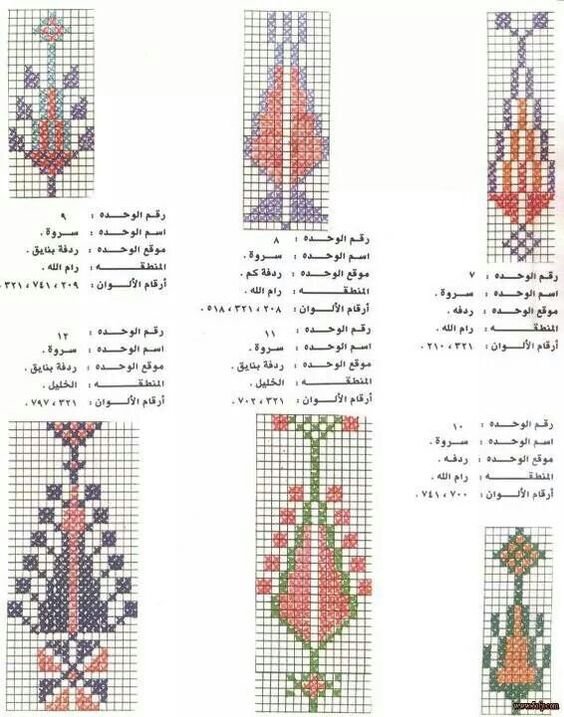QILADA KERCHIEF
In a video posted on Instagram earlier this year, photographer Anas Fteiha shared the story of a grandmother recently dispelled from Gaza to Rafa as she unraveled sweaters with her granddaughter in an effort to have enough wool to crochet hats for a group of children gathered around her. In watching the clip, I was moved by her perseverance and heartened by the bonds of humanity that unite us as knitters and crocheters. As she sat (barefoot next to her tent) and spoke about wanting to keep the children warm, I was struck by the profound love inherent in her work and its resilience even in the face of tremendous hardship.
For this project, I wanted to honor this love and the enduring and rich tradition of Palestinian craft, specifically Palestinian embroidery. I wanted to celebrate the unwavering dedication and artistry of Palestinian women who have shared and safeguarded their craft for generations.
Throughout history, Palestinian embroidery traditions have gracefully evolved, shaped by a continuous stream of artistic influences, including items traded through their ports in the early 19th century such as tiles, carpets, and religious garments. Out of these rich cultural exchanges emerged a unique aesthetic that blended geometric precision with abstract shapes and more rounded botanical patterns.
Prior to 1948, each Palestinian village imbued this artistic expression with its own distinctive preferences and flair. In places like Jaffa for example, they adorned their dress skirts extravagantly, while in villages like Ramallah, they preferred less embellishment. The variations in motif presentation, color palettes, and thread choices reflected the identities of each village. Beyond mere decoration, for the women who embroidered (and it was exclusively women), the motifs became a language of their own and communicated their stories of lineage, tradition, and social hierarchy.
A glimpse of the many incarnations of the “Cypress Tree” motif. This image depicts versions from Ramallah and Al-Khalil. From Odeh, Mai, Palestinian Embroidery, Pinterest.
After the Nakba, when many Palestinian embroiderers were displaced and forced to acclimate to new surroundings, the skills and ideas they shared with each other led to an amalgam of styles. Despite this blending, seasoned embroiderers, especially older ones, are still able to discern patterns and presentation styles from their ancestral villages.
One of the several beautiful books I was able to find on Palestinian embroidery included one by Widad Kamel Kawar and Tania Tamari Nasir called Palestinian Embroidery, where the authors provide extensive examples of the different styles unique to each region of Palestine and lay the book out accordingly. For those interested in the striking collection of images they assembled, the book is generously available (to view or download) on the Tiraz Centre website: https://www.tirazcentre.org/en/free-download
Another wonderful resource and extensive archive of motifs can be found here: https://tirazain.com/archive
During my exploration, I was drawn to a motif known as "The Necklace" (Qilada in Arabic) which I first spotted on a thobe (a traditional Palestinian dress) originating from the Ashdod region of Gaza, crafted sometime between 1920 and 1930 (in a book also titled Palestinian Embroidery by Shelagh Weir and Serene Shahid).
I began to envision a scaled-down portion of it suitable for a kerchief-sized project—which I considered to be a doable size for a first-time cross-stitcher like myself. I knew that I wanted to use a base of Tunisian crochet (enamored as I have long been with the smooth, grid-like fabric created by the Tunisian simple stitch), and I began to experiment with graph paper to see how I could stitch elements of “The Necklace” onto a triangle.
Kelson Goods custom hand dyed all of the beautiful yarn and colors I used for the project and drew upon traditional palettes to create a vibrant trio of brick red, electric pink and apricot. With the base triangle made out of their Workshirt yarn (a smooth superwash merino with lovely stitch definition), I cross-stitched using their Fable (an elegant highland wool) which worked exceptionally well and provided the perfect amount of coverage on top of the Workshirt.
For those not yet familiar with Tunisian crochet, I made sure to include detailed how-to images at every step and a list of all required materials can be found below. Cross-stitching onto the fabric is quite easy to do and I found that a rhythm develops when doing it that helps to keep the process engaging and fun. In traveling quite a bit while developing the pattern, I also found the materials to be wonderfully portable and perfect to take along for any travel you may also have ahead.
The 11-page pattern is $10 and 100% of the proceeds will be donated to UNRWA.
A few additional links to share:
https://thisweekinpalestine.com/a-selection-of-palestinian-embroidery-books/
https://thisweekinpalestine.com/the-journey-of-palestinian-embroidery/
https://www.palestinemuseum.us/
https://www.baytalfann.com/post/the-art-of-tatreez-palestinian-embroidery
From photographer Anas Fteiha, the clip referenced above:
MATERIALS YOU WILL NEED
Main Color: 2 skeins of Workshirt from Kelson Goods (80% superwash merino, 20% nylon) in Muslin. Each 115g skein is approximately 430 yards (393 meters). Approximately 515 yards (471 meters) required.
Cross Stitch Yarns A, B and C: 1 ball each of Kelson Goods Fable (100% pure Highland Wool) in Brick Red (A), Apricot (B), Electric Pink (C). Each 20g ball is approximately 91 yards (104 meters). Approximately 86 yards (79 meters) required of Color A, 55 yards (51 meters) needed of Color B and 73 yards (67 meters) needed of Color C.
Size F (3.75 mm) Tunisian crochet hook with a 12” cord.
A few removable stitch markers
Tapestry needle
A printer to print out 4-page chart
GAUGE
22 squares horizontally = 4 inches in Tunisian Crochet Simple Stitch.
27 squares vertically = 5 inches in Tunsian Crochet Simple Stitch.
SIZE
Finished Length of Wingspan: 34¾ inches
Finished Length from Foundation Edge to Bind-Off Point: 17¾ inches







